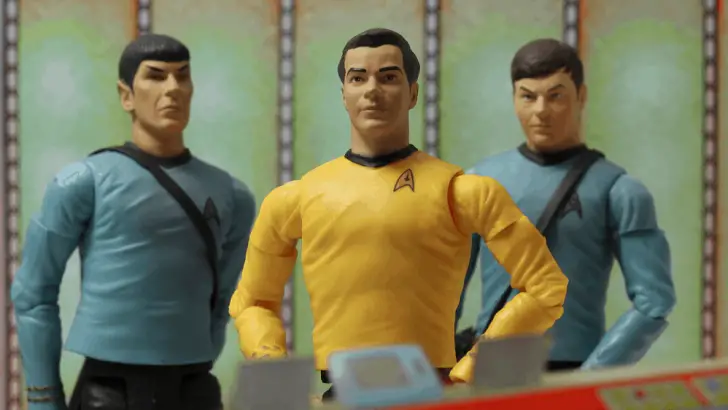If you’ve watched the TV show Star Trek: Enterprise, then you’ve heard the concerns the crew had about the teleporters (known as transporters) in the show. These concerns were that the transporters weren’t safe for humans to use because they dematerialize your atoms. That sounds like it would essentially kill you, right?
Creators of Star Trek haven’t confirmed transporters kill you. However, based solely on the science, transporters do kill you. These teleportation devices take scans of the molecules in your body, store them in the pattern buffer, convert them into energy, and then beam them to the desired location.
Let’s take a look at the science behind these teleporters and how they are meant to work.
The Science of Teleportation – Star Trek Style
The transporter/teleportation devices in the Star Trek universe have been a hot topic of debate since they were introduced in Star Trek: The Original Series. There are many characters of the franchise who have a fear of using the machine. This fear may actually be warranted.
Throughout the franchise, viewers have been given snippets on how the futuristic technology works. There have been books written by the show’s art departments and creators. However, these nuggets of information aren’t always the most realistic.
The science of the teleporter is no different. In fact, the very nature of what the device does isn’t possible if you consider everything it does and real-life physics. According to the official Star Trek website, the transporter will convert a person into energy, send that energy to your desired location, and then reassemble that person back into matter.
The transporters do this by ripping apart your atoms and molecules. Now, real-life physics and biology would suggest that to be an impossible thing to do without killing the person in the process. So, based on that, these transporters in Star Trek do, in fact, kill you.
However, many fans believe that since the human’s consciousness is retained after the body is reassembled that you aren’t actually dying. This poses a morality question on whether or not we should use the transporters in the first place.
Let’s take a look at the actual process below to see how humanity can be okay with this potential murder device.
The Transporter Scans Your Body
The overall aspect of the first part of the transporter process is pretty simple. The machine takes a scan of your body, right down to the atom level. This is looking at your entire molecular makeup. Every molecule and atom in your body (inside and out) gets accounted for and copied.
It isn’t hard to wrap your brain around this part of the process, especially these days. In the real world, there are several different devices that do exactly what the transporter does in this stage, just not with biological material. These real world devices are things like X-Ray and MRI machines.
The Teleporter Converts Your Atoms Into Energy
This is where things get a little tricky and potentially dangerous. Once the scan has been made, your body is broken down into energy. This is known as a matter stream.
What this means is that your body is ripped apart atom by atom until it’s simply a stream of disconnected energy and matter. The dematerialization isn’t supposed to hurt the person being transported. It also happens at the same time as the next step, which is storing a copy in the pattern buffer.
This is the part of the process that many fans believe kills the original person being transported. If you are taken apart at the atomic level, how can you still be alive in any sense of the world? Based on what is known from real world science and biology and physics, there’s no chance you’d survive this step.
To make the science simple, the amount of energy needed to complete the entire process of being transported is equal to that of a bolt of lightning. While it could be possible to survive getting struck by lightning, it isn’t a very likely thing to happen.
There are fans who feel that since your mind is preserved with little to no delay in consciousness, that you aren’t being killed at all. The problem is that your original body is being destroyed. So, in a way, it would appear as though you are being killed.
It Saves a Copy in the Pattern Buffer
Once the transporter has converted you into the energy stream, it makes a detailed copy of everything about you and stores it in the pattern buffer. This has been used in many situations throughout the franchise to fix transporter accidents.
There have been accounts where the pattern buffer was used to store people for several years. One instance of this happened in 2295 when Captain Scott’s ship was in distress. The pattern buffer was able to keep Captain Scott safe for 74 years before the crew of the Enterprise-D found him and rematerialized him.
This is not an ideal situation. Technically, the pattern buffer is only capable of keeping this matter stream stored for seven minutes. After that, the stream degrades, and it isn’t guaranteed to return people to their pre-transporter conditions.
Captain Scott was able to preserve himself and another member of his crew within the transporter. Unfortunately, the other person stored in the pattern buffer wasn’t lucky enough to rematerialize after they were rescued from the transporter.
In the end, the copy of you is needed in order to bring you back together at your destination. Transporters actually have two pattern buffers in their systems to work as a backup in case one of them goes down.
The Transporter Beams the Data Stream to the Desired Location
After you’ve been converted into energy and safely stored into the pattern buffer, the transporter uses an emitter array to send your matter stream to the desired location.
This energy beam is similar to the ones used on starships for tractor beams and phase beams. These beams are alike because it’s pure energy that makes them possible, and it comes from the emitter array. However, when transporters send the matter stream, the stream doesn’t appear to beam down as the tractor beam does.
One of the biggest scientific issues here is the fact that Star Trek seems to be able to beam you into almost any location. They do place some limitations on the where, but for the most part, those limits involve extremely dense materials (mountains, rocks) and sometimes if there is a force field blocking the signal. Based on real science, that just isn’t possible.
Finally, the Transporter Reassembles the Atoms of the Data Stream
Once the matter stream has been beamed to the location, your atoms and molecules are reassembled. It’s here that many fans believe the person who is beamed down is, in fact, just a copy of the original person.
The problem involved here is that in order for this to work, there would need to be a second device on the receiving end. Without a device at the destination, there’s no scientific way for your atoms and molecules to be reassembled in the correct way.
Star Trek doesn’t utilize this two-point system at all, not even in the early prequel series like Star Trek: Enterprise. Now, that sounds like a death sentence right there.
What Does All This Mean in the End?
The key to making science fiction work for its viewers is to make it as believable as possible. This means there has to be some possibility that it could be real. There are actual formulas that measure the amount of energy needed to convert a human being into a matter stream. Or how much radiation would be needed to beam and reassemble a human.
The results of these formulas aren’t possible in our time. The amount of energy to convert you into a matter stream is unobtainable. As an example, the amount of energy needed would be equal to roughly 130 thousand times more powerful than the atomic bomb from 1945.
Furthermore, the level of radiation needed to beam the matter stream anywhere isn’t even known to us. Gamma radiation is the highest level of radiation known to man, and even that is too weak to send the amount of energy a matter stream would contain.
Think about those levels of energy and radiation. Then think about exposing the human body to enough of both. No wonder some of the characters are nervous about using it!
Take a look at the five-minute video below for a quick recap of how transporters work and the trouble they can cause:
Are You Merely a Copy After Being Transported?
It isn’t just the fans who believe it’s just a copy at the end of the transporter. There are characters on the show who have voiced these concerns as well.
Doctor McCoy is well known within the franchise for voicing his fears of using the transporter device. If your body is being ripped apart at the atomic level and put back together somewhere else, are you actually just a copy?
While there are characters who fear the transporter, there are others who try their best to reassure them of their safety. Spock has been referenced as saying a few times that “a difference which makes no difference is no difference.” This is a quote from William James.
If our full consciousness is retained and put into the copy, wouldn’t we essentially still be ourselves? Once the original you is destroyed, wouldn’t the copy become the original you? Since there can only be one of you, it would stand to reason that the copy is, in fact, the new original.
Transporter Speeds and Distances
One of the biggest things to consider when characters wanted to use the transporter within the show was that it shouldn’t be used at warp speed. This is because there are serious distortions that can occur when atoms try to reassembly at different speeds.
Transporting at warp speed could be possible, and was accomplished in-universe. The best way to accomplish this was to ensure both destinations were traveling at the exact same speed.
The range is important to keep in mind as well. This range will be different between species. By the time of Picard, humans have a range of 40 thousand kilometers. Other species have longer or shorter distances, depending on their own limitations.
The further away your desired destination is, the more degraded the matter stream within the pattern buffer can remain intact. You risk your atoms being put together incorrectly.
Transporter Malfunctions and Accidents
There have been many transporter malfunctions and accidents across the franchise. These accidents typically occur when there is a problem with defective equipment.
- Combining two crew members – In the TV show Star Trek: Voyager, two crew members were combined into one being as a result of a transporter malfunction.
- Creating duplicates – In an episode of Star Trek: The Next Generation, another William Riker was created and stranded on another planet with no one having any clue he existed.
- Objects embedded inside people – Star Trek: Enterprise shows how dangerous the transporter can be when the crew beams up a crew member in distress. He makes it back onto the ship with leaves embedded in his skin.
- Age reversal – Also in The Next Generation, members of the crew, Riker, and Picard included, were reversed in age to that of 12-year-old kids.
- Death – There are several instances when the transporter devices of the franchise have killed crew members.
Check out the video below for a clip of a transporter accident from Star Trek: The Motion Picture:
Characters With Fears of Being Transported
There are many characters who have some level of fear when it comes to transporter devices. Most famously being Doctor McCoy and Lt. Barclay, or the entire crew from the TV adaptation, Star Trek: Enterprise.
These characters may have had some good reasoning for being so afraid of the transporter. In addition to the fact that your body is being ripped apart atom by atom, there are also serious side effects that could occur—one of these being Transporter Psychosis.
Check out the video below of a scene from Star Trek: The Next Generation (season six, episode two), when Lt. Barclay asks the computer to explain the condition to him:
Real World Teleporting
While we’re still light-years away from being able to teleport a biological object, there are instances when humans have succeeded in producing a kind of teleportation. These aren’t at all the way we see it done on Star Trek, but they’re as close to it as you can actually get with the technology we have today.
Fax Machines
One of the first types of teleportation devices could be considered the fax machine. This device took a scan of your letter or notice and sent the information to another machine. It replicated the original in another location.
Now, this goes back to the question many ask about the transporters. Is it just a copy then? Well, yes. But if you were to destroy the original, wouldn’t the copy then become the original? Couldn’t we say the same for a human being transported?
3D Printers
3D printers are capable of being a version of teleportation. In fact, in 2015, some German researchers were able to create a device that uses a scanner and a 3D printer to “teleport” objects to new locations.
This simply involves the computer scanning the object and sending the information to its new desired location, much like a fax machine. After that, the 3D printer will create the object. This type of device is more readily available to people these days. It’s as close as we can get to teleporting objects.
Quantum Teleportation
There is an instance of real world teleportation that exists today called Quantum Teleportation. However, it isn’t quite the way we know it from Star Trek. In fact, this method of teleportation wasn’t discovered until the 1990s. There are plenty of formulas that explain what this process is and what it means for the transporters of Star Trek.
Basically, this method shows that the state of atoms can be transported to another location. However, there is a catch. There’s a rule with this kind of science, and that is there is no cloning allowed. In order for every last atom in your body to be transported, the original would have to be completely destroyed. Then and only then can this quantum teleportation succeed in creating the copy at the desired location.
Check out the video below for more details about teleportation in relation to Star Trek’s transporters:
The following video gives a more in-depth approach to the workings of quantum teleportation and quantum entanglement:
Summary
There you have it. The Star Trek franchise would have us believe the people who use these teleporters are completely fine. Perhaps they are, in a way. However, science seems to suggest otherwise. Based on real world physics and science, the Star Trek teleporters do actually kill you.
Sources
- Wikipedia: Transporter (Star Trek)
- Wikipedia: Star Trek: The Original Series
- Fandom: Transporter phobia
- Star Trek: Transporter
- Star Trek: Pattern-buffer
- Fandom: Pattern buffer
- Fandom: Matter stream
- Wikipedia: USS Enterprise (NCC-1701-D)
- Quora: How does the transporter work in Star Trek?
- Fandom: Emitter array
- Wikipedia: Energy beam
- L-Università ta’ Malta: The Transporter in Star Trek: Can it Work?
- Thought Co: Star Trek: Instantaneous Matter Transport
- YouTube: Transporters and Quantum Teleportation
- IFL Science: The Horrifying Truth About Star Trek Transporters
- YouTube: The Trouble with Transporters
- YouTube: How to Teleport Schrödinger’s Cat
- YouTube: Doctor Google
- Wikipedia: William James
- Live Science: Science Fiction or Fact: Will Teleporters Ever Beam Us Up?
- SyFy: THE TERRIBLE TRUTH ABOUT STAR TREK’S TRANSPORTERS
- Forbes: The Physics Of Star Trek: Quantum Teleportation Versus Transporters
- Nasa: The Science of Star Trek
- First Post: STAR TREK-STYLE TRANSPORTER COMES CLOSER TO REALITY
- Fandom: Is the Star Trek Transporter Killing Someone Each Time They Use It?
- Stack Exchange: In Star Trek, does the original die in teleportation?
- Ars Technica: Is beaming down in Star Trek a death sentence?
- Fandom: Alfred Korzybski
- How Stuff Works: 10 ‘Star Trek’ Technologies That Actually Came True
- Edition: Beam me up: Just how close are we to teleportation?
- Space: The Top 10 Star Trek Technologies
- The Guardian: Teleportation: will it ever be a possibility?
- Live About: 12 Worst Transporter Accidents on “Star Trek”
- YouTube: Star Trek The Motion Picture – Transporter Malfunction
- Fandom: Transporter accident
- Wikipedia: Star Trek: Enterprise
- Wikipedia: Gamma ray
- Wikipedia: Star Trek: Voyager
- Wikipedia: 3D printing Processes and printers
- Wikipedia: Star Trek: The Next Generation
- Wikipedia: Fax
- Wikipedia: Quantum teleportation
- Wikipedia: Star Trek: The Motion Picture




